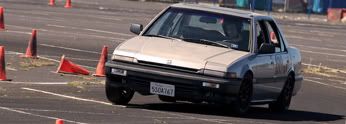So I noticed this forum doesn't talk a lot about driving technique? I wrote this rant earlier to answer someones question I figured I'd throw it up here just case it might help someone.
What happens when you step on the brake pedal? LOTS of things happen but the specifics don't matter. As the driver all you are concerned with is feel and control. I'll say it again, feel and control.
I could tell you the entire chain of events that happens so your foot can stop the tires but it'd probably literally take pages... so lets just concentrate on the byproducts of braking. Namely; Bite, Traction, Slip, Fade and weight-transfer.
The initial feel of the brakes is what I call bite. Bite is good. Good brakes have bite. Barqs Rootbear also has bite... Bite means you get to apply maximum braking instantly but more importantly bite = feel. If you can feel when the brakes engage and how hard they engage you can better modulate the brakes (or just use ABS) to keep them at their threshold where they do the most work.
The grip of the tires is obviously Traction. Traction is good. Good tires have traction. Traction means you can actually use your good brakes with bite but more importantly traction = control.
Loss of traction is what I call slip. Slip can be good but only when you want to slip. Slip is mostly bad. Slip is bad for traction and slip ruins bite. Slip = loss of control.
Fade is loss of friction. Loss of friction is bad. Your brakes (and your tires) depend on friction to function. Bite in your brakes (or tires) can cause fade if they are sucky brakes. Fade means you no longer feel whats happening. Fade = loss of feel.
Weight-Transfer is the result of g-loading. Sharp steering, hard braking or hard throttle can cause weight-transfer. This isn't a bad thing. Weight-transfer can improve traction and control when used properly.
Now back on topic. You are likely to understeer under braking if you initiate heavy or sharp braking after turn-in. This is a result of slip in the tires because you applying braking after the car takes a set.
However when you initiate braking before turn-in (like you're supposed too) the weight-transfer of braking puts more load on the front tires which also momentarily increases their traction. As you turn-in smoothly you ease off the brakes smoothly. The trick is to use that extra traction from the forward weight-transfer at turn-in when you need it most!
Sounds simple enough doesn't it? Now for some advanced techniques based on that principle...
Super-late-braking is basically waiting to initiate that weight-transfer for turn-in at the last possible second. That way you don't waste any speed approaching the corner. On a racetrack this is the most common means to overtake. This technique requires good bite in the brakes, mastery of threshold braking and good traction in the tires.
Trail-braking means you don't release the brakes completely until you reach the apex (roughly the middle) of the corner where you start to accelerate out of the turn. The advantage of this technique (and also the risk) is that you can brake deeper into the corner. This technique is the most difficult because it requires the most control and excellent judgement of your entry speed. You also need excellent traction and brakes that do not fade!
When you use trail-braking, you are basically controlling the foward and lateral weight-transfer like a balancing act. In addition to maintaining constant forward g-load you need to maintain constant lateral g-load as well.
Basically the reason for this is balance. Race drivers (especially circle-track guys) try and maintain constant loading of the tires via brakes, steering and throttle through a corner. If your judgement is off you spin or worse understeer up into the wall...
Think of it like this, the whole of the forward g-load (brakes) and the whole of the lateral g-load (steering) must not exceed the limit. In other words, the limit of traction cannot be multiplied. It can only be divided.
Thus, when you are entering, holding, and leaving a corner you can't stack the loads on top of eachother and expect a higher limit. You have to redistribute the loads as you are going through a corner or you will exceed the limit.
To reiterate you brake until you hit the limit of your traction before turn-in. Then you smoothly release the brakes adding steering to keep your tires loaded all the way to the apex where your lateral-g's are the highest. Then you smoothly apply throttle as you unwind the wheel to achieve the highest possible exit speed. It requires feel and control to do all these things fluidly.



 Reply With Quote
Reply With Quote












Bookmarks